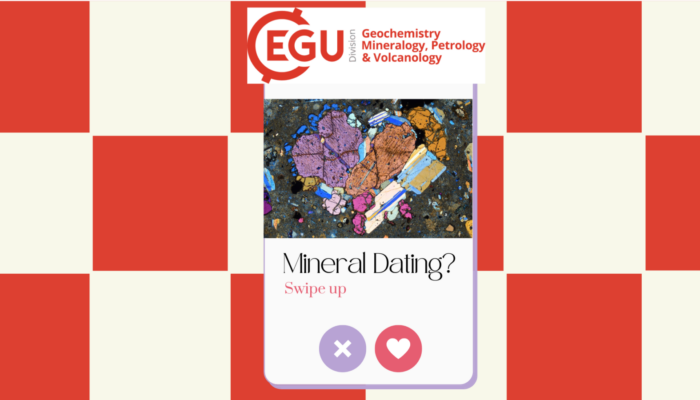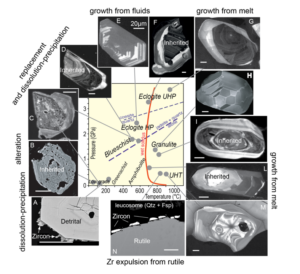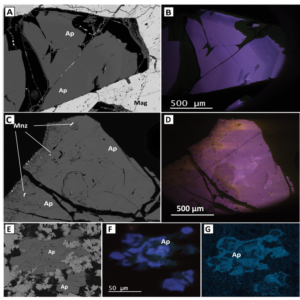
When it comes to dating profiles, minerals can put up a really good face at first. But, as some of the users in dating apps out there, they might not be worthy of a second try, or maybe not even of a first depending on what your intentions are…
To help out, we will tackle some of the main minerals used in geochronology, as if they were featured on online dating apps, plus some ‘red flags’ from previous lovers users. The four first candidates are in.

Zircon and Garnet as dating profiles. (Photomicrographs: Zircon by Kurt Hollocher and Garnet by Guto Paiva-Silva)
ZIRCON (ZrSiO4)
Chemically stable, with a high closure temperature and natural trace amounts of uranium. Your U-Pb isotopic system king!
ID-TIMS, LA-ICP-MS, and SIMS oriented, depending on the mood.
Especially interested in understanding crustal evolution, tectonic processes and metamorphic events, as well as provenance determinations. I REALLY love to hear – and record – history!

Typical internal zoning and textures of zircons from different metamorphic grades (as in Rubatto, 2017)
Red flags:
Depending on the stars alignment, identifying zircon can be a tricky and time-consuming task, and in most cases you do need plenty of grains to get a good age. Lots of time together is required to flourish this relationship!- Zircon can lose its
temperlead during high-grade metamorphism, potentially complicating age interpretations. If you plan to flirt with pressure and temperature, make sure of this possibility and act in accordance. - Past relations and their trauma, am I right?! The presence of inclusions and alteration zones within zircon grains can affect U-Pb systematics, so a thorough characterisation is mandatory. Caution is advised, as currently no therapy is available for poor zircon.
- Careful analyses and interpretation are required to distinguish between different geological events recorded in zircon. The guy is a library, so a methodic cataloguing of all he has to tell, much like a diary if one must say, is the way to go!
GARNET – (Fe2+, Mn, Mg, Ca)3(Al, Fe3+, Cr)2Si3O12, but I do have variations and nicknames)
Stable, able to incorporate trace elements and with a variable composition and zoning. Your metamorphic goddess!
U-Pb, Sm-Nd, Lu-Hf systems – versatility babe.
Metamorphic events (prograde and retrograde) and tectonic processes are my true calling – I just keep on recording all the stages and variations. A sensitive girl, don’t let me get started on my astrological chemical map.
ID-TIMS, LA-ICP-MS, and/or SIMS – I’ll tell you all the right gossip if you use the right tools.

Cr, Mn, and Ti zoning from a garnet from the Monviso ophiolite of the Western Alps (as in Baxter et al. 2017)
Red flags
- As a very sensitive and friendly person, Garnet may present inclusions, fluids and exhibit compositional zoning (chemical changes, a profound conversation), requiring careful techniques (microanalytical even) to avoid contamination and accurately interpret the data.
- When the heat comes, be sure to put the whole picture into perspective and proceed with caution. Elemental diffusion within garnet can affect age interpretations, particularly at high temperatures.
- She’s no basic diva! Garnet may record complex growth histories, necessitating detailed petrological studies to fully understand the geochronological data. Just get your data in order and organise an ideas board to not get lost, it could get overwhelming.

Monazite and Apatite as dating profiles. (Photomicrographs: Monazite as in Catlos et al. 2002 and Apatite as in Hazrah and Antao 2002).
MONAZITE – (Ce,La,Th)PO4, your rare-earth element guru
A phosphate commonly enriched in rare earth elements and thorium. Stable, with a high closure temperature and radiogenic lead content.
U-Pb and Th-Pb are my go-to isotopic systems.
EMPA (yes honey, microprobe analyses!), LA-ICP-MS, and SIMS, she’s everywhere.
Provenance, metamorphic processes (growth and recrystallisation), tectonic events and crustal evolution enthusiast – let’s chat and figure it all out.
Red flags
- As a very meticulous and into chemistry person, monazite often exhibits compositional zoning (life variations, who doesn’t have them?!). We’re talking possibly complicated age interpretations, but also elaborate metamorphic histories.
- Monazite can lose
control oflead under certain conditions, potentially affecting age accuracy. Caution is advised! - Background is always important! The presence of inclusions and alteration zones can affect U-Pb and Th-Pb systematics, just check whether you’re dealing with the right
persongrain before committing to something more serious.
APATITE – (Ca5(PO4))3(F,OH,Cl)
One can say I have multiple personalities, it all depends on my connections (hydroxyl, fluor and chloride, you name it).
Trace amounts of U and Th, just enough to get us going. But some Lu-Hf is available if that’s what you’re focusing on.
LA-ICP-MS or SIMS, where are we meeting?!
Fission tracks babe. Let’s talk about scars and (thermal) history.
Crystallisation, cooling, thermal events, ore-formation processes, metamorphism and fluid. I’m (always) there for you!

BSE and cathodoluminescence (CL) images for apatite from the El Laco ore bodies (as in La Cruz et al. 2020)
Red flags
- Apatite can lose Pb, especially under high temperatures or metamorphic conditions, or even due to surface weathering. A deep and detailed background check is always advised.
- In life sometimes we win, others we lose. Accounting for initial (non-radiogenic) Pb loss or incorporation is necessary to obtain accurate ages. Better be safe than sorry.
- Chemical zoning is always a possibility. Affinities change as life goes by, so concentrations of U, Th, and Pb are variant. And life processes never stop. Keep a diary and write down all details honey, so nothing is left unidentified or corrected!
- Apatite can contain
life scars a.k.a. mineral inclusions, which may have different U-Pb systematics, potentially contaminating the analyses.
Final comment: A more thorough study of the applications of the above minerals in geochronology is strongly recommended, as here the information has been abridged and adapted to suit the purpose of the article, mimicking what is commonly seen in online dating profiles. The ‘Petrochronology: Methods and Applications’ series, edited by Matthew J. Kohn, Martin Engi and Pierre Lanari, (and all the references therein) constitute a good start point, but recent papers (e.g. Simpson et al. 2023, on in-situ Lu–Hf geochronology) are also suggested.


Yuri Ribeiro
I enjoyed a lot the text, congrats!